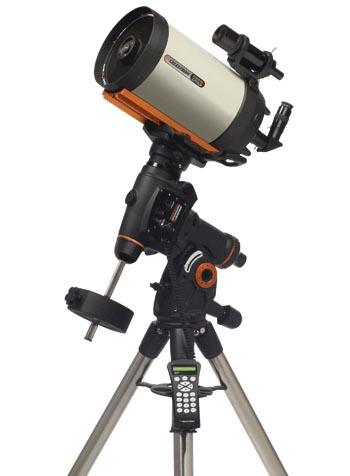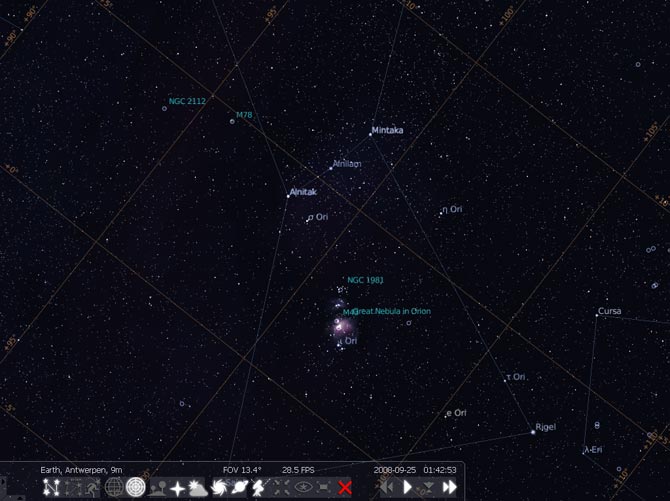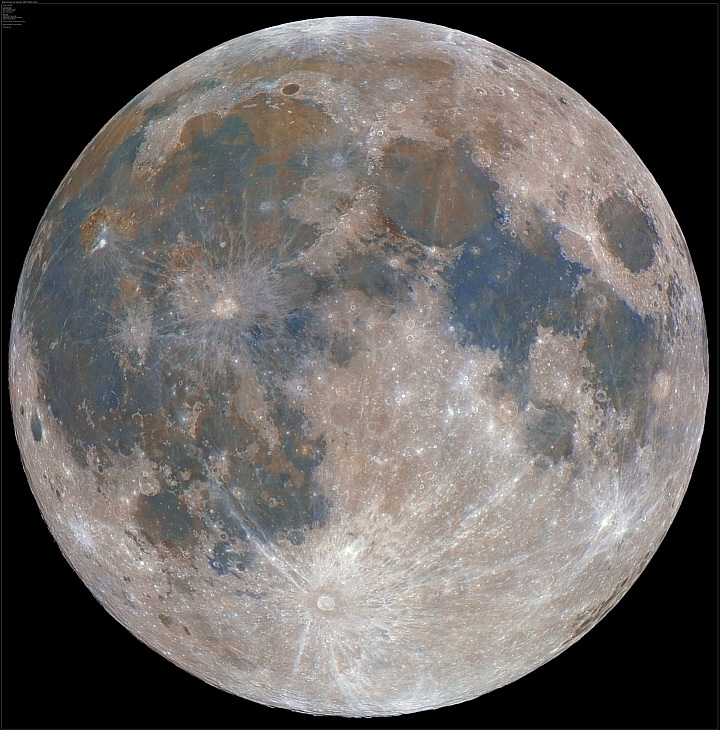
Astrofotografie - Celestron CGEM 800 HD - 203mm, GoTo - 2.890,00 EUR
Celestron CGEM 800 HD - 203mm Öffnung 2032mm Brennweite
korrigiertes Bildfeld für Astrofotografie
... komplettes Teleskop auf leistungsstarker GoTo Montierung CGEM
... komplettes Teleskop auf leistungsstarker GoTo Montierung CGEM
Celestron EdgeHD sind aplanatische Schmidt Teleskope produziert für ein fehlerfreies und geebnetes großes Gesichtsfeld für Astrofotografie. Jedes Celestron HD Teleskop bietet ein komafreies und voll korrigiertes Bildfeld für Astrofotografie und natürlich auch für Beobachtung. Die HD Schmidt Teleskope sind die neueste Entwicklung von Celestron, basierend auf jahrelanger Erfahrung im Bau von hochwertigen Schmidt Cassegrains.
Die Vorteile der Celestron EdgeHD Schmidt Teleskope:
-- großes und vollständig korrigiertes Bildfeld für Astrofotografie - eben und komafrei
-- uneingeschränkte visuelle Tauglichkeit
-- Fixierung des Hauptspiegels - verhindert ein Verschieben des Spiegels während der Belichtung
-- Hauptspiegelbelüftung für ein schnelleres Auskühlen
-- Jedes HD Schmidt Teleskop ist Fastar kompatibel und kann so in eine Schmidt Camera umgebaut werden
Weitere Informationen zu den EdgeHD:
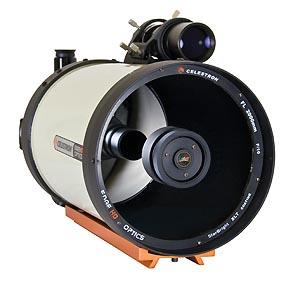 | Besonders helles Bild: Celestron verfügt mit der StarBright XLT Vergütung über eine der besten Vergütungen, die wir kennen. Damit bieten die HD Teleskope ein besonders helles und kontrastreiches Bild. Fastar kompatibel: Bauen Sie mit dem HyperStar Upgrade das HD Teleskop mit nur wenigen Handgriffen in eine f/2 CCD Schmidt Kamera um. Das HyperStar Kit ist im Bereich "empfohlenes Zubehör" verlinkt. Leistungsstarker 9x50 Sucher: Jedes HD Teleskop kommt mit einem guten multivergüteten 9x50 Sucher, der das Auffinden der Objekte deutlich erleichtert. |
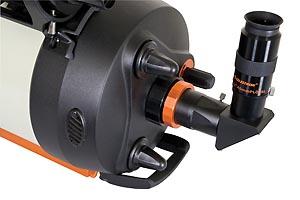 | Innovative 1,25" Klemmung: Das Zubehör wird über eine robuste 1,25" Klemmung fixiert. Die Klemmung erfolgt absolut gleichmäßig über die gesamte Fläche. Neues elegantes Design: Nicht nur technisch, sondern auch im Design setzt Celestron mit den HD Schmidt Teleskopen neue Maßstäbe. |
| Technische Daten des 800 HD: -- Öffnung ... 203mm -- Brennweite ... 2032mm -- Öffnungsverhältnis ... f/10 -- Maximal sinnvolle Vergrößerung ... 480x -- Grenzgröße ... 14m0 -- Auflösung ... 0,57" -- Abschattung durch den Fangspiegel ... 68,5mm (33,8%) -- Tubuslänge ... 431mm Lieferumfang des 800 HD: -- optischer Tubus -- 9x50 Sucher -- 2" Zenitspiegel -- 40mm 1,25" Okular |
Infos zur Celestron CGEM - parallaktische Montierung mit Computersteuerung - bis ca. 20kg Instrumentengewicht... massive GoTo Montierung für Geräte bis 11" Öffnung - gut für Astrofotografie geeignet. 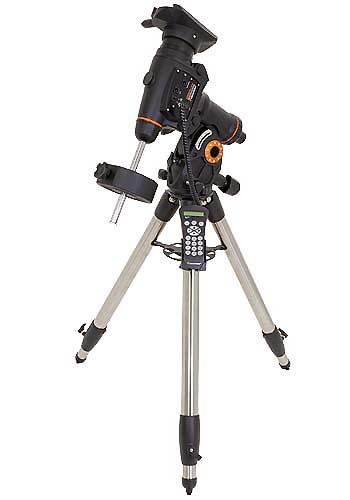 Die CGEM Montierung von Celestron bietet, neben einem attraktiven Design, auch gute innere Werte. Die Montierung schließt die Lücke zwischen der bewährten Advanced GoTo Montierung (CAM) und der massiven CGE. Die CGEM kann mit Geräten, bis ca. 20kg Eigengewicht beladen werden, je nach Anwendung und Hebel. Eingebaute Nachführung mit automatischer Objektpositionierung ... Die CGEM kommt mit einer kompletten GoTo Steuerung mit ca. 40.000 eingespeicherten Objekten und einer sauber arbeitenden Nachführung. Besonders massive Polhöhe ... Große Rändelschrauben in Azimut und Höhe ermöglichen ein bequemes Einstelle der Montierung, auch bei voller Beladung. Die Polhöhe ist besonders massiv gebaut und gibt der Montierung eine höhere Stabilität. Innovative Einnordung für Astrofotografie ... Die CGEM hst eine besonders effektive Einnordungsprozedur (All Star - patent pending). Für eine genaue Einnordung genügt es, nach der Eichung des Computers, einfach einen hellen Stern anzufahren. Die Software kalkuliert dann die Abweichung von der optimalen Einnordung und teilt dann mit, wie weit die Montierung im Azimut und in der Polhöhe noch korrigiert werden muß. Ein Polsucher ist nicht mehr nötig. Permanente elektronische Korrektur des Schneckenfehlers ... Auch sehr wichtig für die Astrofotografie - die permanente Korrektur des periodischen Fehlers. Die Montierung merkt sich die Korrektur. Die Nachführung wird genauer. Damit ist die Montierung besonders gut für Astrofotografie geeignet. Die Montierung geht über den Meridian hinaus ... Besonders praktisch, wenn langbelichtete Astroaufnahmen gemacht werden und das Objekt währenddessen den Meridian passiert. Die Belichtung kann fortgeführt werden. Die Mechanik der Montierung erlaubt ein Nachführen weit über den Meridiandurchgang hinaus, ohne Umschwenken. Stabile 3" Prismenklemme ... Die CGEM verfügt bereits über die gleiche massive 3" Prismenklemme, wie die Celestron CGE oder die Losmandy Montierungen. Die 3" Klemmung erlaubt die Verwendung der stabilen großen Prismenschienen. Weniger Schwingungen und mehr Steifigkeit des Gesamtsystems sind das Ergebnis. Massives Edelstahlstativ ... Das höhenverstellbare Edelstahlstativ ist ausfahrbar bis 140cm Höhe. Die Stabilität wird dabei voll aufrecht erhalten. Der weite Verstellbereich bringt die Montierung immer in die richtige Arbeitshöhe, je nach Instrumententyp. Die Computersteuerung:
|
Die Montierung und der Lieferumfang:
-- parallaktische Montierung mit Instrumenten bis zu 20kg belastbar-- Montierungsgewicht ... 18.6kg
-- Stativgewicht ... 7,7kg
-- 9 Verstellgeschwindigkeiten ( 5°/sek, 2°/sek, 1°/sek, 64x, 16x, 8x, 4x, 1x, 0,5x )
-- Nachführgeschwindigkeiten - Siderial, Solar und Lunar
-- Umschaltung Nord/Süd
-- Stromversorgung - 12V / 1,5 Ampere - Zigaretten Anzünder Kabel dabei
-- Ein Gegengewicht mit ca. 5kg ist in der Grundausstattung dabei
-- Permanente Korrektur des Nachführfehlers (NexRemote Software)
-- RS232 Kabel
Astrofotografie - Skywatcher Explorer - 304mm, 12" - 1.698,00 EUR !!!
Skywatcher Explorer-300PDS / 12" f/5
Parabol Newton Reflektor - 2"
Crayford Auszug mit 1:10 Mikrountersetzung
.. auf parallaktischer Montierung EQ6 SkyScan Pro mit
.. auf parallaktischer Montierung EQ6 SkyScan Pro mit
Nachführung und automatischer Objektpositionierung
... perfektes Teleskop für Astrofotografie mit ausreichend Back Fokus
Explorer-300PDS 12" f/5 Newton auf EQ6 GoTo - 2" Crayford - 1.698,00 EUR !!!
Explorer-300PDS 12" f/5 Newton auf EQ6 GoTo - 2" Crayford - 1.698,00 EUR !!!
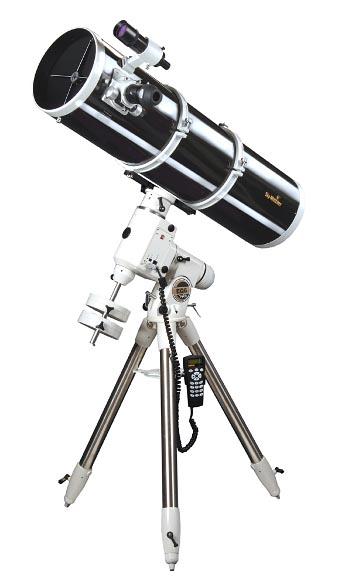
Abbildung - Explorer 250PDS
Die GoTo Montierung EQ6 Pro SkyScan
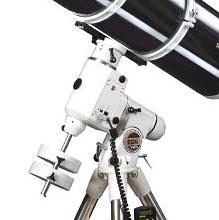
Die stabile GoTo Montierung EQ6 PRO SkyScan von Skywatcher bietet eine genaue Nachführung, Autoguiding Anschluss und natürlich eine präzise Objektpositionierung. Die Montierung ist für Teleskope bis ca. 21kg geeignet. Damit bestehen Stabilitätsreserven für Kameras aber auch für ein Leitrohr. Die EQ6 ist ein idealer Unterbau für dieses leistungsstarke Teleskop.
...................................................................................................................... Mehr Infos zur EQ6 SkyScan Pro

Die stabile GoTo Montierung EQ6 PRO SkyScan von Skywatcher bietet eine genaue Nachführung, Autoguiding Anschluss und natürlich eine präzise Objektpositionierung. Die Montierung ist für Teleskope bis ca. 21kg geeignet. Damit bestehen Stabilitätsreserven für Kameras aber auch für ein Leitrohr. Die EQ6 ist ein idealer Unterbau für dieses leistungsstarke Teleskop.
...................................................................................................................... Mehr Infos zur EQ6 SkyScan Pro
Der neue Skywatcher Explorer 300PDS bietet zwei besondere Vorteile für die Astrofotografie. Er verfügt über einen 2" Crayford Okularauszug mit 1:10 Mikro Untersetzung für hochgenaues Scharfstellen und bietet genügend Platz für die problemlose Adaption von allen gängigen Kameras am Markt. Natürlich überzeugt auch dieser Newton mit der bewährten beugungsbegrenzt arbeitenden parabol Hauptspiegel aus Pyrex. Natürlich ist der Newton Reflektor auch uneingeschränkt für die Beobachtung tauglich.
Die Vorteile des Explorer-300PDS:
-- beugungsbegrenzt arbeitende parabolische Optik für scharfe und kontrastreiche Abbildung
-- 2" Crayford Okularauszug mit 1:10 Mikro Untersetzung - ideal für Astrofotografie
-- genügend Back Fokus für alle gängigen Kameras
-- solider Metalltubus mit hoher Steifigkeit
Der 2" Crayford Auszug mit 1:10 Mikro Untersetzung:
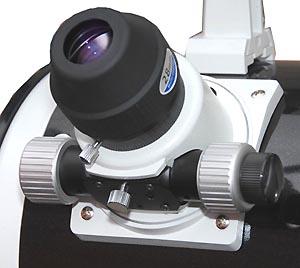
Der neue 2" Crayford Okularauszug ermöglicht eine hochgenaue Scharfstellung für knackscharfe Astrofotos. Darüber hinaus ist die mechanische Stabilität sehr hoch. Selbst Kameras mit mehr, als 2kg Eigengewicht werden noch gut gehalten. Im Lieferumfang ist eine Reduzierung auf 1,25" Steckdurchmesser enthalten.
Technische Daten:
-- Öffnung: 304mm
-- Brennweite: 1500mm
-- Öffnungsverhältnis: f/5
-- Spiegel: parabolischer Spiegel - beugungsbegrenzte Abbildung
-- Durchmesser Fangspiegel: 70mm kleine Achse
-- Fangspiegelstrebe: 0,5mm ultradünne Streben für minimale Beugungserscheinungen
Astronomy Software - Celestia
Celestia provides photo-realistic, real-time, three-dimensional viewing of the solar system, the galaxy and the universe. It is an easy to use, freely-distributed, multi-platform, open source, software package which has become a valuable tool for astronomy education. Used in homes, schools, museums and planetariums around the world, it also is used as a visualization tool by space mission designers. Versions are available for computers running Windows, Macintosh (Mac OS X) and Linux operating systems.
And, for some reason, many people seem to find exploring with Celestia to be a lot of fun.
Welcome to Celestia
... The free space simulation that lets you explore our universe in three dimensions.
Celestia runs on Windows, Linux, and Mac OS X.
Unlike most planetarium software, Celestia doesn't confine you to the surface of the Earth. You can travel throughout the solar system, to any of over 100,000 stars, or even beyond the galaxy.
All movement in Celestia is seamless; the exponential zoom feature lets you explore space across a huge range of scales, from galaxy clusters down to spacecraft only a few meters across. A 'point-and-goto' interface makes it simple to navigate through the universe to the object you want to visit.
Celestia is expandable. Celestia comes with a large catalog of stars, galaxies, planets, moons, asteroids, comets, and spacecraft. If that's not enough, you can download dozens of easy to install add-ons with more objects.

Introduction to Celestia
Many of us have looked up at the stars on a dark night and wondered what it would be like to launch ourselves into space and soar among the stars. What do the astronauts of the Space Shuttle really see when they look down upon our beautiful Earth turning slowly below? What wonders might we encounter if we could visit Saturn alongside the Cassini spacecraft and sail right through its rings? If you have ever wondered about these things and would like to find out the answers, we of the Celestia community are happy to introduce you to Celestia!
Celestia is a free real-time space simulation that lets you visually experience our universe in three dimensions. Celestia was the initial inspiration and creation of Mr. Chris Laurel, a Seattle, WA computer programmer who in 2001, decided to write a free software program to be made available to everyone on the world-wide-web that would place you in control of a virtual reality world of the universe. His vision and dedication gave birth to a program that is unlike any other space simulation program in existence. Celestia doesn't confine you to the surface of the Earth as do many other programs. Instead, Chris created a dynamic capability to travel throughout the Solar System and elsewhere in space, at any speed, at any moment of time and in any direction you choose. If you wish, you can fly via your own “hyperdrive” spacecraft to visit stars within the spiral arms of the Milky Way beyond the confines of our Sun, or leave the galaxy entirely to view the bigger universe from deep space. Chris also insisted this program would be scientifically accurate … a true source of dynamic astronomical graphics.
When Celestia version 1.0 first appeared available for download on the Internet, space enthusiasts all over the world discovered and quickly realized the potential of this beautiful program. Within a year, many talented people worldwide joined Chris in a collaborative volunteer effort to make Celestia into not only a good graphical space simulation but into a great one, capable of producing a meticulously accurate virtual universe rivaling the visual quality seen only in Hollywood films.
They have succeeded. As of this writing, over 6,600 members of the public are part of the Celestia forum community. Over 3 million people have downloaded the program for use at home or school. It is in use in homes, schools, government agencies and media outlets throughout the world. The list grows daily and includes talented graphic artists, computer programmers, astronomers, astrophysicists, planetarium directors, animators, engineers, teachers and students, professionals from government, private occupations and ordinary citizens in over 25 countries. Together, they have created a world of space that utilizes not only the basic Celestia program, but over 18 gigabytes of add-ons and extras that truly bring your Celestia experience to life. We invite you to join the Celestia forum by clicking here.
Celestia 1.5.1 is available free of charge for Windows, Linux, and Mac OS X from http://www.shatters.net/celestia/download.html. Hopefully, you’ve already downloaded Celestia and are ready to install it and experience the beauty of space. Using some of the add-ons available for the program, here is just a taste of what you will be able to encounter:
v Learn the unbelievable size and magnitude of our universe firsthand, with a journey from the surface of Earth to the far reaches of our observable universe … at hyperspeed.
v Watch solar flares and prominences rising off the Sun and measure its rotation using sunspots.
v Hover over each of the planets in our Solar System as they rotate slowly below you. See clouds drift by (where applicable) and shadows being cast on mountains and craters as the Sun sets low.
v Fly along with Mariner 10 on its historic flyby of Mercury.
v Visit the searing surface of Venus and view it in a panoramic 360° vista from the surface.
v Take a spin down to the Earth’s surface in your own hyperdrive spacecraft. Skim over the oceans of Earth as you fly below the clouds. Soar back into space to see the lights come on in the cities of Earth.
v Be present as Apollo 11 lands on the Moon in 1969, or fly by Sputnik 1 in 1958 shortly after its launch.
v Rendezvous with the ISS or the Hubble Space Telescope. Attempt a docking at the ISS Shuttle port.
v Peer through the primary focus from inside the Hale Telescope on Palomar mountain.
v View Earth’s Magnetic Field from space and see the Aurora glowing and shimmering.
v Display an internal X-section of Earth and peer deeply into its tectonic layers and structure.
v Discover Mir as it passes over the Russian homeland with its cosmonaut crew onboard.
v See the massive size of Hurricane Katrina as it makes landfall on New Orleans.
v Hover over Mar’s Gusev crater and Meridiani Planum and drop down to visit Spirit and Opportunity, then fly over to Olympus Mons and Valles Marineris and fly through the canyon itself.
v Be there in the year 2029 when the asteroid Apophis will approach Earth on a possible collision course.
v Observe a spectacular lunar eclipse of our own Moon and a total solar eclipse on Earth.
v Position yourself above Jupiter and watch as its large moons drift across the face of the planet, casting multiple eclipse shadows on its banded clouds and Great Red Spot.
v Examine the actively erupting volcanoes on Jupiter’s moon Io. Fly through a spewing volcanic plume.
v Hover far beyond Saturn, plunge through its rings, and count its 60 moons.
v Witness Cassini arrive in Saturn space in 2004 and drop the Huygens probe into the atmosphere of Titan in January 2005. Follow Huygens down toward a parachute landing on Titan’s surface.
v Journey to the frozen wasteland of Pluto and its three moons and see their icy coldness for yourself.
v Take up station behind comet Halley in 1986 as its gaseous lavender tail streams out behind it near Earth.
v Seek out Ceres, Eris and Makemake, our Solar System’s newest “dwarf planets”.
v Fly out to the edges of our Solar System and follow Voyagers 1 and 2 as they head to distant stars.
v Witness the impact of the Deep Impact spacecraft onto the surface of comet Tempel1 in July 2005.
v Set your ship at faster-than-light speed and sail to Rigel Kentaurus A, located 4.3 light years away.
v View the red glow of sunlight on Gliese 581c, an earthlike world orbiting it’s small red dwarf star.
v Travel in time to 3000 CE to witness giant mirrors melt the Martian polar ice caps and help to terraform Mars into a verdant world of water, plants and cities of the future.
v Travel far into the future and rendezvous with a colossal rotating Space Station as it orbits Earth.
v Journey to the edges of a massive rotating Black Hole as it spins near its stellar companion. Witness another Black Hole swallowing its companion star.
v Travel to the heart of Betelgeuse, a distant Red Supergiant star that will Hypernova someday.
v See stellar creation from deep within the Rosette and Eagle Nebulas, giant stellar nurseries.
v Observe for yourself the deep field galaxies that were photographed by the Hubble Space Telescope.
v Hear the pulses of the new pulsar in the Crab Nebula, spinning before you at over 30 times a second.
v Witness the end of Earth, as it is swallowed by our swelling Red Giant sun billions of years from now.
v Jump at hyperspeed to the Andromeda spiral galaxy, M 87 located in the rich Virgo Cluster or the beautiful Whirlpool galaxy, or visit over ten thousand galaxies, accurately drawn.
v Cruise next to Cosmos, a revolutionary new spacecraft that may someday “sail” on a wind of pure sunlight.
v Travel backward in time 4 billion years to witness the planet “Orpheus” catastrophically collide with Earth to actually form our Moon.
v Learn what efforts are being taken to discover if extraterrestrial intelligence exists in the universe.
v Travel in tandem with the USS Enterprise commanded by Captain Picard as it battles the Borg Empire.
v Travel in the whimsical world of Hollywood and visit the StarWars® worlds of Tatooine, Endor and Hoth. Fly next to the Imperial Death Star or Star Destroyer as the Millennium Falcon swoops in for an attack.
v Fly directly through a theoretical wormhole on your way to a distant solar system.
v Explore numerous fictional solar systems, complete with meticulously detailed, exotic alien civilizations, terraformed moons, futuristic space stations, space fleets, and interstellar spacecraft.
These are just a few of Celestia’s features. Each week, new features are being added by Celestia’s programmers and other talented contributors. It is a program undergoing a rapid evolution in computer graphics. Add-on features, for example, will include entirely new solar systems with dozens of planets and moons drawn in vivid detail, sound effects, gaseous nebula clouds, new galaxies, stars, globular clusters and spacecraft both real and imaginary. Periodically as new features are added, this User’s Guide will also be revised. If this list above excites you, let’s get started on our journey into the heart of Celestia.
Astronomy Software - Stellarium
Stellarium is a free open source planetarium for your computer. It shows a realistic sky in 3D, just like what you see with the naked eye, binoculars or a telescope. It is being used in planetarium projectors. Just set your coordinates and go.
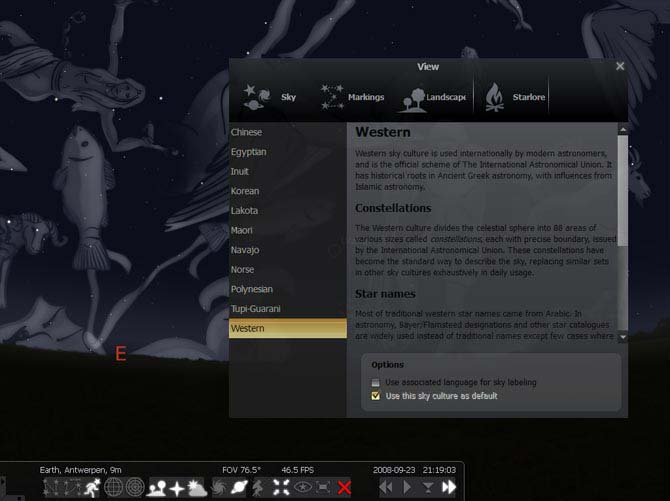
features
in version 0.10.6sky
- default catalogue of over 600,000 stars
- extra catalogues with more than 210 million stars
- asterisms and illustrations of the constellations
- constellations for twelve different cultures
- images of nebulae (full Messier catalogue)
- realistic Milky Way
- very realistic atmosphere, sunrise and sunset
- the planets and their satellites
interface
- a powerful zoom
- time control
- multilingual interface
- fisheye projection for planetarium domes
- spheric mirror projection for your own low-cost dome
- all new graphical interface and extensive keyboard control
- telescope control
visualisation
- equatorial and azimuthal grids
- star twinkling
- shooting stars
- eclipse simulation
- skinnable landscapes, now with spheric panorama projection
customizability
- plugin system adding artifical satellites, ocular simulation, telescope configuration and more
- ability to add new solar system objects from online resources...
- add your own deep sky objects, landscapes, constellation images, scripts...
Lista Constelaţiilor
Această listă conţine constelaţiile astronomice în ordinea alfabetică a denumirilor latine.
| Numele latin | Numele românesc | Prescurtare | Genitivul latin | Steaua principală | Stabilită de |
|---|---|---|---|---|---|
| Andromeda | Andromeda | And | Andromedae | Alpheratz (Sirrah) | Ptolemeu |
| Antlia | Maşina Pneumatică | Ant | Antliae | Lacaille | |
| Apus | Pasărea Paradisului | Aps | Apodis | Bayer | |
| Aquarius | Vărsătorul | Aqr | Aquarii | Sadalmelik | Ptolemeu |
| Aquila | Vulturul | Aql | Aquilae | Atair | Ptolemeu |
| Ara | Altarul | Ara | Arae | Ptolemeu | |
| Aries | Berbecul | Ari | Arietis | Hamal | Ptolemeu |
| Auriga | Vizitiul | Aur | Aurigae | Capella | Ptolemeu |
| Bootes | Boarul | Boo | Bootis | Arcturus | Ptolemeu |
| Caelum | Dalta | Cae | Caeli | Lacaille | |
| Camelopardalis | Girafa | Cam | Camelopardalis | Plancius | |
| Cancer | Racul | Cnc | Cancri | Acubens | Ptolemeu |
| Canes Venatici | Câinii de Vânătoare | CVn | Canum Venaticorum | Cor Caroli | Hevelius |
| Canis Major | Câinele Mare | CMa | Canis Majoris | Sirius | Ptolemeu |
| Canis Minor | Câinele Mic | CMi | Canis Minoris | Prokyon | Ptolemeu |
| Capricornus | Capricornul | Cap | Capricorni | Deneb Algedi | Ptolemeu |
| Carina | Carena | Car | Carinae | Canopus | Lacaille |
| Cassiopeia | Cassiopeia | Cas | Cassiopeiae | Schedir | Ptolemeu |
| Centaurus | Centaurul | Cen | Centauri | Rigil Kentaurus | Ptolemeu |
| Cepheus | Cefeu | Cep | Cephei | Alderamin | Ptolemeu |
| Cetus | Balena | Cet | Ceti | Menkar | Ptolemeu |
| Chamelaeon | Cameleonul | Cha | Chamaeleontis | Bayer | |
| Circinus | Compasul | Cir | Circini | Lacaille | |
| Columba | Porumbelul | Col | Columbae | Phakt | Plancius |
| Coma Berenices | Părul Berenicei | Com | Comae Berenices | Diadem | Ptolemeu |
| Corona Australis | Coroana Australă | CrA | Coronae Australis | Alfecca Meridiana | Ptolemeu |
| Corona Borealis | Coroana Boreală | CrB | Coronae Borealis | Alphekka (Gemma) | Ptolemeu |
| Corvus | Corbul | Crv | Corvi | Alchiba | Ptolemeu |
| Crater | Cupa | Crt | Crateris | Alkes | Ptolemeu |
| Crux | Crucea | Cru | Crucis Australis | Acrux | Hevelius |
| Cygnus | Lebăda | Cyg | Cygni | Deneb | Ptolemeu |
| Delphinus | Delfinul | Del | Delphini | Sualocin | Ptolemeu |
| Dorado | Peştele de Aur | Dor | Doradus | Bayer | |
| Draco | Dragonul | Dra | Draconis | Thuban | Ptolemeu |
| Equuleus | Calul Mic | Equ | Equulei | Kitalpha | Ptolemeu |
| Eridanus | Eridanul | Eri | Eridani | Achernar | Ptolemeu |
| Fornax | Cuptorul | For | Fornacis | Fornacis | Lacaille |
| Gemini | Gemenii | Gem | Geminorum | Castor | Ptolemeu |
| Grus | Cocorul | Gru | Gruis | Al Nair | Bayer |
| Hercules | Hercule | Her | Herculis | Ras Algethi | Ptolemeu |
| Horologium | Orologiul | Hor | Horologii | Lacaille | |
| Hydra | Hidra | Hya | Hydrae | Alphard | Ptolemeu |
| Hydrus | Hidra Australă | Hyi | Hydri | Bayer | |
| Indus | Indianul | Ind | Indi | Bayer | |
| Lacerta | Şopârla | Lac | Lacertae | Hevelius | |
| Leo | Leul | Leo | Leonis | Regulus | Ptolemeu |
| Leo Minor | Leul Mic | LMi | Leonis Minoris | Praecipua | Hevelius |
| Lepus | Iepurele | Lep | Leporis | Arneb | Ptolemeu |
| Libra | Balanţa | Lib | Librae | Zuben Elgenubi | Ptolemeu |
| Lupus | Lupul | Lup | Lupi | Ptolemeu | |
| Lynx | Linxul | Lyn | Lyncis | Hevelius | |
| Lyra | Lira | Lyr | Lyrae | Vega | Ptolemeu |
| Mensa | Platoul | Men | Mensae | Lacaille | |
| Microscopium | Microscopul | Mic | Microscopii | Lacaille | |
| Monocerus | Licornul | Mon | Monocerotis | Hevelius | |
| Musca | Musca | Mus | Muscae | Hevelius | |
| Norma | Echerul | Nor | Normae | Lacaille | |
| Octans | Octantul | Oct | Octantis | Lacaille | |
| Ophiuchus | Ofiucus | Oph | Ophiuchi | Ras Alhague | Ptolemeu |
| Orion | Orion | Ori | Orionis | Beteigeuze | Ptolemeu |
| Pavo | Păunul | Pav | Pavonis | Joo Tseo | Bayer |
| Pegasus | Pegas | Peg | Pegasi | Markab | Ptolemeu |
| Perseus | Perseu | Per | Persei | Mirphak (Algenib) | Ptolemeu |
| Phoenix | Phoenix | Phe | Phoenicis | Ankaa | Bayer |
| Pictor | Pictorul | Pic | Pictoris | Lacaille | |
| Pisces | Peştii | Psc | Piscium | Alrischa | Ptolemeu |
| Piscis Austrinus | Peştele Austral | PsA | Piscis Austrini | Fomalhaut | Ptolemeu |
| Puppis | Pupa | Pup | Puppis | Naos | Lacaille |
| Pyxis | Busola | Pyx | Pyxidis | Lacaille | |
| Reticulum | Reticulul | Ret | Reticuli | Lacaille | |
| Sagitta | Săgeata | Sge | Sagittae | Sham | Ptolemeu |
| Sagittarius | Săgetătorul | Sgr | Sagittarii | Rukbat | Ptolemeu |
| Scorpius | Scorpionul | Sco | Scorpii | Antares | Ptolemeu |
| Sculptor | Sculptorul | Scl | Sculptoris | Lacaille | |
| Scutum | Scutul | Sct | Scuti | Hevelius | |
| Serpens | Şarpele | Ser | Serpentis | Unukalhai | Ptolemeu |
| Sextans | Sextantul | Sex | Sextantis | Hevelius | |
| Taurus | Taurul | Tau | Tauri | Aldebaran | Ptolemeu |
| Telescopium | Telescopul | Tel | Telescopii | Lacaille | |
| Triangulum | Triunghiul | Tri | Trianguli | Metallah | Ptolemeu |
| Triangulum Australis | Triunghiul Austral | TrA | Trianguli Australis | Atria | Bayer |
| Tucana | Tucanul | Tuc | Tucanae | Bayer | |
| Ursa Major | Ursa Mare | UMa | Ursae Maioris | Dubhe | Ptolemeu |
| Ursa Minor | Ursa Mică | UMi | Ursae Minoris | Polaris | Ptolemeu |
| Vela | Velele | Vel | Velorum | Suhail al Muhlif | Lacaille |
| Virgo | Fecioara | Vir | Virginis | Spica | Ptolemeu |
| Volans | Peştele Zburător | Vol | Volantis | Bayer | |
| Vulpecula | Vulpea | Vul | Vulpeculae | Hevelius |
Meniu Postari
- Lista Constelaţiilor
- AQUARIUS (AQR) - Varsator
- Cum puteti modifica un webcam pentru al utiliza cu...
- Crab Nebula - M1
- Nebuloasa Crab vazuta de Hubble
- Ce este o gaură neagră ?
- Ce credeti ca se va intimpla in 2012 ?!
- Cele mai frumoase imagini cu galaxii si nebuloase ...
- Imagini unice surprinse de telescopul Hubble
- The Next Generation” der Astronomie-Kameras
- NGC 7293: The Helix Nebula
- Astronomy Picture of the Day
- Software pentru astronomie
- Telescopes for Digital Astrophotography
- Notiuni de astrofotografie
- Tipuri de monturi
- Ce este un telescop astronomic?
- Astronomy Picture of the Day - 2006 December 28
- Spiral Galaxies in Collision
- Lista obiectelor Messier
- Ssc2006-21a1
- Messier 31 (M31, NGC 224) is the famous Andromeda ...
- Catalogul Messier
- Table of Constellations
- O noua ciudatenie a Universului iese la iveala – p...
- Astronomii au inregistrat pentru prima data moarte...
- Eclipsă parţială de Soare la 4 ianuarie 2011
- Orion UP - un telescop hibrid
- Astronomy Picture of the Day Archive 2010 Index
- Astronomy Picture of the Day
- 21.Dec.2012 - Sfarsit sau inceput ???
- Softul astronomic Cartes du Ciel
- Harta Cerului - Ianuarie 2011
- Harta Cerului - Decembrie 2010
- Comet Hale-Bopp passes near the North America Nebu...
- Prima eclipsă lunară care coincide cu solstiţiul d...
- Cea mai masiva galaxie
- Cel mai indepartat roi de galaxii
- Imaginea saptamanii
- Noi imagini de la telescopul WISE
- Imaginea saptamanii - frumoasa spirala
Abonnieren
Posts (Atom)
